A Novel Hydroxyapatite/Vitamin B12 Nanoformula for Treatment of Bone Damage: Preparation, Characterization, and Anti-Arthritic, Anti-Inflammatory, and Antioxidant Activities in Chemically Induced Arthritic Rats
Abstract
1. Introduction
2. Results
2.1. Characterization of Nano-HAP and Nano-HAP/Vit B12
2.2. Molecular Modeling of HAP/Vit B12
2.3. Effect of Nano-HAP/Vit B12 on Gross Lesions of the Paw and Ankle Joints
2.4. Effect of Nano-HAP/Vit B12 on Right Hind Paws Volume
2.5. Effect of Nano-HAP/Vit B12 on LPO, GSH Content, and GST Activity
2.6. Effects of Nano-HAP/Vit B12 on Serum RF, CRP, TNF-α, IL-1β, IL-17, IL-4, ADAMTS-5 and TIMP3 Levels
2.7. Effect of Nano-HAP/Vit B12 on TGF-β mRNA Expression
2.8. Histopathological Changes and Arthritic Score
3. Discussion
4. Materials and Methods
4.1. Chemicals
4.2. Preparation of Nano-HAP and Nano-HAP/Vit B12
4.3. Characterization of Nano-HAP and Nano-HAP/Vit B12
4.4. Molecular Modeling
4.5. Experimental Animals
4.6. Induction of Arthritis and Animal Grouping
4.7. Assessment of Paw Edema
4.8. Collection of Blood and Tissue
4.9. Biochemical Investigations
4.10. Biomarkers of the Antioxidant Defense System and Oxidative Stress Measurement
4.11. Histopathological Investigation
4.12. q-RT-PCR Analysis
4.13. Statistical Analysis
5. Conclusions
Supplementary Materials
Author Contributions
Funding
Institutional Review Board Statement
Informed Consent Statement
Data Availability Statement
Acknowledgments
Conflicts of Interest
References
- Silvagni, E.; Giollo, A.; Sakellariou, G.; Ughi, N.; D’Amico, M.E.; Scirè, C.A.; Huizinga, T.W. One year in review 2020: Novelties in the treatment of rheumatoid arthritis. Clin. Exp. Rheumatol. 2020, 38, 181–194. [Google Scholar] [CrossRef] [PubMed]
- Komatsu, N.; Takayanagi, H. Mechanisms of joint destruction in rheumatoid arthritis—Immune cell–fibroblast–bone interactions. Nature Rev. Rheum. 2022, 18, 415–429. [Google Scholar] [CrossRef] [PubMed]
- Ain, Q.; Zeeshan, M.; Khan, S.; Ali, H. Biomimetic hydroxyapatite as potential polymeric nanocarrier for the treatment of rheumatoid arthritis. J. Biomed. Mater. Res. Part A 2019, 107, 2595–2600. [Google Scholar] [CrossRef]
- Cross, M.; Smith, E.; Hoy, D.; Nolte, S.; Ackerman, I.; Fransen, M.; Bridgett, L.; Williams, S.; Guillemin, F.; Hill, C.L.; et al. The global burden of hip and knee osteoarthritis: Estimates from the Global Burden of Disease 2010 study. Ann. Rheum. Dis. 2014, 73, 1323–1330. [Google Scholar] [CrossRef] [PubMed]
- Smolen, J.S.; Aletaha, D.; Koeller, M.; Weisman, M.H.; Emery, P. New therapies for treatment of rheumatoid arthritis. Lancet 2007, 370, 1861–1874. [Google Scholar] [CrossRef]
- Aletaha, D.; Smolen, J.S. Diagnosis and management of rheumatoid arthritis: A review. JAMA 2018, 320, 1360–1372. [Google Scholar] [CrossRef]
- Biemond, P.; Swaak, A.J.; Koster, J.F. Protective factors against oxygen free radicals and hydrogen per-oxide in rheumatoid arthritis synovial fluid. Arthritis Rheum. Off. J. Am. College Rheum. 1984, 27, 760–765. [Google Scholar]
- Ozturk, H.S.; Çimen, M.Y.B.; Çimen, O.B.; Kaçmaz, M.; Drek, M.J. Oxidant/antioxidant status of plasma samples from patients with rheumatoid arthritis. Rheumatol. Int. 1999, 19, 35–37. [Google Scholar] [CrossRef]
- Leonavičienė, L.; Bradūnaitė, R.; Vaitkienė, D.; Vasiliauskas, A.; Keturkienė, A. Collagen-induced arthritis and pro-/antioxidant status in Wistar and Lewis rats. Biologija 2008, 54, 290–300. [Google Scholar] [CrossRef]
- Bracht, A.; Silveira, S.S.; Castro-Ghizoni, C.V.; Sá-Nakanishi, A.B.; Oliveira, M.R.N.; Bersani-Amado, C.A.; Peralta, R.M.; Comar, J.F. Oxidative changes in the blood and serum albumin differentiate rats with monoarthritis and polyarthritis. Springerplus 2016, 5, 36. [Google Scholar] [CrossRef]
- Makuch, S.; Więcek, K.; Woźniak, M. The Immunomodulatory and Anti-Inflammatory Effect of Curcumin on Immune Cell Populations, Cytokines, and In Vivo Models of Rheumatoid Arthritis. Pharmaceuticals 2021, 14, 309. [Google Scholar] [CrossRef]
- Burmester, G.R.; Pope, J.E. Novel treatment strategies in rheumatoid arthritis. Lancet 2017, 389, 2338–2348. [Google Scholar] [CrossRef]
- Smolen, J.S.; Aletaha, D.; Barton, A.; Burmester, G.R.; Emery, P.; Firestein, G.S.; Kavanaugh, A.; McInnes, I.B.; Solomon, D.H.; Strand, V.; et al. Rheumatoid arthritis. Nat. Rev. Dis. Prim. 2018, 4, 18001. [Google Scholar] [CrossRef] [PubMed]
- Rahman, M.M.; Afsana, S.; Khan, M.S.; Islam, M.R.; Haque, M.; Mitra, S.; Emran, T.B.; Rauf, A. Multi-functional therapeutic approach of nanomedicines against inflammation in cancer and aging. J. Nanomater. 2022, 2022, 4217529. [Google Scholar] [CrossRef]
- Ramesh, N.; Moratti, S.C.; Dias, G.J. Hydroxyapatite-polymer biocomposites for bone regeneration: A review of current trends. J. Biomed. Mater. Res. Part B Appl. Biomater. 2018, 106, 2046–2057. [Google Scholar] [CrossRef]
- Haider, A.; Haider, S.; Han, S.S.; Kang, I.-K. Recent advances in the synthesis, functionalization and biomedical applications of hydroxyapatite: A review. RSC Adv. 2017, 7, 7442–7458. [Google Scholar] [CrossRef]
- Mekmene, O.; Quillard, S.; Rouillon, T.; Bouler, J.M.; Piot, M.; Gaucheron, F. Effects of pH and Ca/P molar ratio on the quantity and crystalline structure of calcium phosphates obtained from aqueous solutions. Dairy Sci. Technol. 2009, 89, 301–316. [Google Scholar] [CrossRef]
- Köse, S.; Kankilic, B.; Gizer, M.; Dede, E.C.; Bayramli, E.; Korkusuz, P.; Korkusuz, F. Stem Cell and Advanced Nano Bioceramic Interactions. Nov. Biomat. Regen. Med. 2018, 1077, 317–342. [Google Scholar] [CrossRef]
- Weissig, V.; Pettinger, T.K.; Murdock, N. Nanopharmaceuticals (part 1): Products on the market. Int. J. Nanomed. 2014, 9, 4357–4373. [Google Scholar] [CrossRef]
- Nabipour, Z.; Nourbakhsh, M.S.; Baniasadi, M. Evaluation of ibuprofen release from gelatin/hydroxyapatite/polylactic acid nanocomposites. Iranian J. Pharmaceut. Sci. 2018, 14, 75–84. [Google Scholar]
- Prasanna, A.B.; Venkatasubbu, G.D. Sustained release of amoxicillin from hydroxyapatite nanocomposite for bone infections. Progress Biomater. 2018, 7, 289–296. [Google Scholar] [CrossRef] [PubMed]
- GadelHak, Y.; Salama, E.; Tawab, S.A.-E.; Mouhmed, E.A.; Alkhalifah, D.H.M.; Hozzein, W.N.; Mohaseb, M.; Mahmoud, R.K.; Amin, R.M. Waste Valorization of a Recycled ZnCoFe Mixed Metal Oxide/Ceftriaxone Waste Layered Nanoadsorbent for Further Dye Removal. ACS Omega 2022, 7, 44103–44115. [Google Scholar] [CrossRef] [PubMed]
- Mahmoud, R.; Mohamed, H.F.; Hafez, S.H.; Gadelhak, Y.M.; Abdel-Hady, E.E. Valorization of spent double substituted Co–Ni–Zn–Fe LDH wastewater nanoadsorbent as methanol electro-oxidation catalyst. Sci. Rep. 2022, 12, 19354. [Google Scholar] [CrossRef]
- Varadarajan, V.; Varsha, M.; Vijayasekaran, K.; Shankar, S.V. Comparative studies of hydroxyapatite (HAp) nanoparticles synthesized by using different green templates. AIP Conf. Proc. 2020, 2240, 080002. [Google Scholar] [CrossRef]
- Mohonta, S.K.; Maria, K.H.; Rahman, S.; Das, H.; Hoque, S.M. Synthesis of hydroxyapatite nanoparticle and role of its size in hydroxyapatite/chitosan–gelatin biocomposite for bone grafting. Int. Nano Lett. 2021, 11, 381–393. [Google Scholar] [CrossRef]
- Thommes, M.; Kaneko, K.; Neimark, A.V.; Olivier, J.P.; Rodriguez-Reinoso, F.; Rouquerol, J.; Sing, K.S. Physisorption of gases, with special reference to the evaluation of surface area and pore size dis-tribution (IUPAC Technical Report). Pure Appl. Chem. 2015, 87, 1051–1069. [Google Scholar] [CrossRef]
- Zhang, X.; Yan, L.; Li, J.; Yu, H. Adsorption of heavy metals by l-cysteine intercalated layered double hydroxide: Kinetic, isothermal and mechanistic studies. J. Colloid Interface Sci. 2019, 562, 149–158. [Google Scholar] [CrossRef]
- Slovák, L.; Poništ, S.; Kuncírová, V.; Mihalová, D.; Fedorova, T.; Bauerová, K. Evaluation of the effect of carnosine, its novel derivative trolox-carnosine and trolox in a pre-clinical study focussing on the regulation of immunity. Pharm. J. 2016, 63, 16–19. [Google Scholar] [CrossRef]
- Ahmed, O.M.; EL-Abd, S.F.; El Mahdi, E.A.; Abdou, E.A. Curcumin ameliorative efficacy on type 1 diabetes mellitus coexisted with rheumatoid arthritis in Wistar rats. Merit. Res. J. Med. Med. Sci. 2015, 3, 256–270. [Google Scholar]
- Phull, A.R.; Nasir, B.; Haq, I.; Kim, S.J. Oxidative stress, consequences and ROS mediated cellular signaling in rheumatoid arthritis. Chemicobiol. Interact. 2018, 281, 121–136. [Google Scholar] [CrossRef]
- Sena, L.A.; Chandel, N.S. Physiological roles of mitochondrial reactive oxygen species. Mol. Cell 2012, 48, 158–167. [Google Scholar] [CrossRef] [PubMed]
- Burton, G.J.; Jauniaux, E. Oxidative stress. Best Pract. Res. Clin. Obstet. Gynaecol. 2011, 25, 287–299. [Google Scholar] [CrossRef]
- Ahmed, R.H.; Galaly, S.R.; Moustafa, N.; Ahmed, R.R.; Ali, T.M.; Elesawy, B.H.; Ahmed, O.M.; Abdul-Hamid, M. Curcumin and Mesenchymal Stem Cells Ameliorate Ankle, Testis, and Ovary Deleterious Histological Changes in Arthritic Rats via Suppression of Oxidative Stress and Inflammation. Stem Cells Int. 2021, 2021, 3516834. [Google Scholar] [CrossRef] [PubMed]
- Saleem, A.; Saleem, M.; Akhtar, M.F.; Shahzad, M.; Jahan, S. Moringa rivae leaf extracts attenuate Complete Freund’s adjuvant-induced arthritis in Wistar rats via modulation of inflammatory and oxidative stress biomarkers. Inflammopharmacology 2020, 28, 139–151. [Google Scholar] [CrossRef]
- Singhai, A.; Ahmad, Y.; Patil, U.K. Phyto-therapeutic Potential of Aconitum ferox Roots in CFA-induced Arthritis in Rat Model. Indian J. Pharm. Educ. Res. 2022, 56, s725–s735. [Google Scholar] [CrossRef]
- Quiñonez-Flores, C.M.; González-Chávez, S.A.; Del Río Nájera, D.; Pacheco-Tena, C. Oxidative Stress Relevance in the Pathogenesis of the Rheumatoid Arthritis: A Systematic Review. BioMed Res. Int. 2016, 2016, 6097417. [Google Scholar] [CrossRef] [PubMed]
- Zhu, L.; Zhang, Z.; Xia, N.; Zhang, W.; Wei, Y.; Huang, J.; Ren, Z.; Meng, F.; Yang, L. Anti-arthritic activity of ferulic acid in complete Freund’s adjuvant (CFA)-induced arthritis in rats: JAK2 inhibition. Inflammopharmacology 2019, 28, 463–473. [Google Scholar] [CrossRef]
- Yang, L.; Liu, R.; Fan, A.; Zhao, J.; Zhang, Y.; He, J. Chemical composition of Pterospermum heterophyllum root and its anti-arthritis effect on adjuvant-induced arthritis in rats via modulation of inflammatory responses. Front. Pharmacol. 2020, 11, 584849. [Google Scholar] [CrossRef]
- Arjumand, S.; Shahzad, M.; Shabbir, A.; Yousaf, M.Z. Thymoquinone attenuates rheumatoid arthritis by downregulating TLR2, TLR4, TNF-α, IL-1, and NFκB expression levels. Biomed. Pharmacother. 2019, 111, 958–963. [Google Scholar] [CrossRef]
- Jing, R.; Ban, Y.; Xu, W.; Nian, H.; Guo, Y.; Geng, Y.; Zang, Y.; Zheng, C. Therapeutic effects of the total lignans from Vitex negundo seeds on collagen-induced arthritis in rats. Phytomedicine 2019, 58, 152825. [Google Scholar] [CrossRef]
- Li, X.; Xie, P.; Hou, Y.; Chen, S.; He, P.; Xiao, Z.; Zhan, J.; Luo, D.; Gu, M.; Lin, D. Tangeretin inhibits oxidative stress and inflammation via upregulating Nrf-2 signaling pathway in collagen-induced arthritic rats. Pharmacology 2019, 104, 187–195. [Google Scholar] [CrossRef] [PubMed]
- Lin, B.; Zhang, H.; Zhao, X.-X.; Rahman, K.; Wang, Y.; Ma, X.-Q.; Zheng, C.-J.; Zhang, Q.-Y.; Han, T.; Qin, L.-P. Inhibitory effects of the root extract of Litsea cubeba (lour.) pers. on adjuvant arthritis in rats. J. Ethnopharmacol. 2013, 147, 327–334. [Google Scholar] [CrossRef] [PubMed]
- Pan, T.; Cheng, T.-F.; Jia, Y.-R.; Li, P.; Li, F. Anti-rheumatoid arthritis effects of traditional Chinese herb couple in adjuvant-induced arthritis in rats. J. Ethnopharmacol. 2017, 205, 1–7. [Google Scholar] [CrossRef]
- Li, P.; Yang, X.; Yang, Y.; He, H.; Chou, C.K.; Chen, F.; Pan, H.; Liu, L.; Cai, L.; Ma, Y.; et al. Synergistic effect of all-trans-retinal and triptolide encapsulated in an inflammation-targeted nanoparticle on collagen-induced arthritis in mice. J. Control. Release 2020, 319, 87–103. [Google Scholar] [CrossRef]
- Setiadi, A.Y.L.A.; Karmawan, L.U.; Yanti, Y. Anti-Arthritic and Anti-Inflammatory Effects of Andaliman Extract and Nanoandaliman in Inflammatory Arthritic Mice. Foods 2022, 11, 3576. [Google Scholar] [CrossRef] [PubMed]
- Yu, H.; Zeng, R.; Lin, Y.; Li, X.; Tasneem, S.; Yang, Z.; Qiu, Y.-X.; Li, B.; Wang, Y.-H.; Cai, X.; et al. Kadsura heteroclita stem suppresses the onset and progression of adjuvant-induced arthritis in rats. Phytomedicine 2019, 58, 152876. [Google Scholar] [CrossRef]
- Jiang, C.-P.; He, X.; Yang, X.-L.; Zhang, S.-L.; Li, H.; Song, Z.-J.; Zhang, C.-F.; Yang, Z.-L.; Li, P.; Wang, C.-Z.; et al. Anti-rheumatoid arthritic activity of flavonoids from Daphne genkwa. Phytomedicine 2014, 21, 830–837. [Google Scholar] [CrossRef]
- Genovese, M.C.; Van den Bosch, F.; Roberson, S.A.; Bojin, S.; Biagini, I.M.; Ryan, P.; Sloan-Lancaster, J. LY2439821, A humanized anti-IL-17 monoclonal antibody, in the treatment of patients with rheumatoid arthritis: A phase 1 randomized double-blind, placebo-controlled, proof of concept study. Arthritis Rheum. 2010, 62, 929–939. [Google Scholar] [CrossRef]
- McInnes, I.B.; Schett, G. Cytokines in the pathogenesis of rheumatoid arthritis. Nat. Rev. Immunol. 2007, 7, 429–442. [Google Scholar] [CrossRef]
- Burska, A.; Boissinot, M.; Ponchel, F. Cytokines as Biomarkers in Rheumatoid Arthritis. Mediat. Inflamm. 2014, 2014, 545493. [Google Scholar] [CrossRef]
- Leung, T.K.; Chen, C.H.; Lai, C.H.; Lee, C.M.; Chen, C.C.; Yang, J.C.; Chen, K.C.; Chao, J.S. Bone and joint protection ability of ceramic material with biological effects. Chin. J. Physiol. 2012, 55, 47–54. [Google Scholar] [PubMed]
- Chakraborty, S.; Vimalnath, K.V.; Rajeswari, A.; Shinto, A.; Sarma, H.D.; Kamaleshwaran, K.; Thirumalaisamy, P.; Dash, A. Preparation, evaluation, and first clinical use of 177Lu-labeled hydroxy-apatite (HA) particles in the treatment of rheumatoid arthritis: Utility of cold kits for convenient dose formulation at hospital radiopharmacy. J. Labelled Compd. Radiopharm. 2014, 57, 453–462. [Google Scholar] [CrossRef] [PubMed]
- Habibovic, P.; de Groot, K. Osteoinductive biomaterials—Properties and relevance in bone repair. J. Tissue Eng. Regen. Med. 2007, 1, 25–32. [Google Scholar] [CrossRef] [PubMed]
- Barradas, A.M.C.; Yuan, H.; van Blitterswijk, C.A.; Habibovic, P. Osteoinductive biomaterials: Current knowledge of properties, experimental models and biological mechanisms. Eur. Cells Mater. 2011, 21, 407–429. [Google Scholar] [CrossRef]
- Bau, B.; Gebhard, P.M.; Haag, J.; Knorr, T.; Bartnik, E.; Aigner, T. Relative messenger RNA expression profiling of collagenases and aggrecanases in human articular chondrocytes in vivo and in vitro. Arthritis Rheum. 2002, 46, 2648–2657. [Google Scholar] [CrossRef]
- Yamanishi, Y.; Boyle, D.L.; Clark, M.; Maki, R.A.; Tortorella, M.D.; Arner, E.C.; Firestein, G.S. Ex-pression and regulation of aggrecanase in arthritis: The role of TGF-β. J. Immun. 2002, 168, 1405–1412. [Google Scholar] [CrossRef]
- Pratta, M.A.; Scherle, P.A.; Yang, G.; Liu, R.-Q.; Newton, R.C. Induction of aggrecanase 1 (ADAM-TS4) by interleukin-1 occurs through activation of constitutively produced protein. Arthritis Rheum. 2003, 48, 119–133. [Google Scholar] [CrossRef]
- Tayman, M.A.; Koyuncu, I. Differential gene expression of ADAMTS-1, ADAMTS-9 and TIMP-3 in periodontitis. Biotech. Histochem. 2022, 98, 126–131. [Google Scholar] [CrossRef]
- Brew, K.; Nagase, H. The tissue inhibitors of metalloproteinases (TIMPs): An ancient family with structural and functional diversity. Biochim. Biophys. Acta BBA Mol. Cell Res. 2010, 1803, 55–71. [Google Scholar] [CrossRef]
- Dunn, S.L.; Wilkinson, J.M.; Crawford, A.; Le Maitre, C.L.; Bunning, R.A. Cannabinoid WIN-55,212-2 mesylate inhibits interleukin-1β induced matrix metalloproteinase and tissue inhibitor of matrix metalloproteinase expression in human chondrocytes. Osteoarthr. Cartil. 2014, 22, 133–144. [Google Scholar] [CrossRef]
- Li, W.; Wu, M.; Jiang, S.; Ding, W.; Luo, Q.; Shi, J. Expression of ADAMTs-5 and TIMP-3 in the condylar cartilage of rats induced by experimentally created osteoarthritis. Arch. Oral Biol. 2014, 59, 524–529. [Google Scholar] [CrossRef]
- Mohammed, F.F.; Smookler, D.S.; Khokha, R. Metalloproteinases, inflammation, and rheumatoid arthritis. Ann. Rheum. Dis. 2003, 62, 43–47. [Google Scholar] [CrossRef]
- Szeremeta, A.; Jura-Półtorak, A.; Zoń-Giebel, A.; Kopeć-Mędrek, M.; Kucharz, E.J.; Olczyk, K. Aggrecan Turnover in Women with Rheumatoid Arthritis Treated with TNF-α Inhibitors. J. Clin. Med. 2020, 9, 1377. [Google Scholar] [CrossRef]
- Segal, R.; Baumoehl, Y.; Elkayam, O.; Levartovsky, D.; Litinsky, I.; Paran, D.; Wigler, I.; Habot, B.; Leibovitz, A.; Sela, B.A.; et al. Anemia, serum vitamin B12, and folic acid in patients with rheu-matoid arthritis, psoriatic arthritis, and systemic lupus erythematosus. Rheumatol. Int. 2004, 24, 14–19. [Google Scholar] [CrossRef] [PubMed]
- Chen, X.; Andresen, B.; Hill, M.; Zhang, J.; Booth, F.; Zhang, C. Role of Reactive Oxygen Species in Tumor Necrosis Factor-alpha Induced Endothelial Dysfunction. Curr. Hypertens. Rev. 2008, 4, 245–255. [Google Scholar] [CrossRef] [PubMed]
- Elliott, R.L.; Blobe, G.C. Role of Transforming Growth Factor Beta in Human Cancer. J. Clin. Oncol. 2005, 23, 2078–2093. [Google Scholar] [CrossRef] [PubMed]
- Javelaud, D.; Mauviel, A. Mammalian transforming growth factor-βs: Smad signaling and physio-pathological roles. Int. J. Biochem. Cell Biol. 2004, 36, 1161–1165. [Google Scholar] [CrossRef] [PubMed]
- Li, M.O.; Flavell, R.A. TGF-β: A master of all T cell trades. Cell 2008, 134, 392–404. [Google Scholar] [CrossRef]
- Sanjabi, S.; Zenewicz, L.A.; Kamanaka, M.; Flavell, R.A. Anti-inflammatory and pro-inflammatory roles of TGF-β, IL-10, and IL-22 in immunity and autoimmunity. Curr. Opin. Pharmacol. 2009, 9, 447–453. [Google Scholar] [CrossRef] [PubMed]
- Lu, Y.; Li, L.; Lin, Z.; Wang, L.; Lin, L.; Li, M.; Zhang, Y.; Yin, Q.; Li, Q.; Xia, H. A new treatment mo-dality for rheumatoid arthritis: Combined photothermal and photodynamic therapy using Cu7. 2S4 nanoparticles. Adv. Healthc. Mater. 2018, 7, 1800013. [Google Scholar] [CrossRef]
- Raafat, S.; Al-Naqqash, M.A.; Al-Asady, Z.T.; Al-Asady, S.; Jawad, M.M.; Alosami, M.H. The Cor-relation of TGF-β Level and GARP Gene Expression in Iraqi Patients with Rheumatoid Arthritis Treated By Biological and Chemo-Therapy. Inter. J. Pharm. Res. 2020, 1. [Google Scholar] [CrossRef]
- Ciregia, F.; Deroyer, C.; Cobraiville, G.; Plener, Z.; Malaise, O.; Gillet, P.; Fillet, M.; Malaise, M.G.; de Seny, D. Modulation of αVβ6 integrin in osteoarthritis-related synovitis and the interaction with VTN (381–397 aa) competing for TGF-β1 activation. Exp. Mol. Med. 2021, 53, 210–222. [Google Scholar] [CrossRef]
- Cheon, H.; Yu, S.; Yoo, D.H.; Chae, I.J.; Song, G.G.; Sohn, J. Increased expression of pro-inflammatory cytokines and metalloproteinase-1 by TGF-β1 in synovial fibroblasts from rheumatoid arthritis and normal individuals. Clin. Exp. Immunol. 2002, 127, 547–552. [Google Scholar] [CrossRef] [PubMed]
- Soriente, A.; Amodio, S.P.; Fasolino, I.; Raucci, M.G.; Demitri, C.; Engel, E.; Ambrosio, L. Chitosan/PEGDA based scaffolds as bioinspired materials to control in vitro angiogenesis. Mater. Sci. Eng. 2021, 118, 111420. [Google Scholar] [CrossRef] [PubMed]
- Logashina, Y.; Palikova, Y.; Palikov, V.; Kazakov, V.; Smolskaya, S.; Dyachenko, I.; Tarasova, N.; Andreev, Y. Anti-Inflammatory and Analgesic Effects of TRPV1 Polypeptide Modulator APHC3 in Models of Osteo- and Rheumatoid Arthritis. Mar. Drugs 2021, 19, 39. [Google Scholar] [CrossRef]
- Shaaban, H.H.; Hozayen, W.G.; Khaliefa, A.K.; El-Kenawy, A.E.; Ali, T.M.; Ahmed, O.M. Diosmin and Trolox Have Anti-Arthritic, Anti-Inflammatory and Antioxidant Potencies in Complete Freund’s Adjuvant-Induced Arthritic Male Wistar Rats: Roles of NF-κB, iNOS, Nrf2 and MMPs. Antioxidants 2022, 11, 1721. [Google Scholar] [CrossRef] [PubMed]
- Chen, C.; Huang, Z.; Yuan, W.; Li, J.; Cheng, X.; Chi, R.A. Pressure effecting on morphology of hydroxyapatite crystals in homogeneous system. Cryst. Eng. Comm. 2011, 13, 1632–1637. [Google Scholar] [CrossRef]
- Bolat, M.; Ciocan-Pendefunda, A.; Surlari, Z.; Bida, C.; Balcos, C.; Baciu, R.; Bosinceanu, D.-G. Using shape memory effect to obtain a new polymer for the manufacture of complete dentures. IOP Conf. Ser. Mater. Sci. Eng. 2019, 572, 012014. [Google Scholar] [CrossRef]
- Jain, A.; Ong, S.P.; Hautier, G.; Chen, W.; Richards, W.D.; Dacek, S.; Cholia, S.; Gunter, D.; Skinner, D.; Ceder, G.; et al. Commentary: The Materials Project: A materials genome approach to accelerating materials innovation. APL Mater. 2013, 1, 011002. [Google Scholar] [CrossRef]
- Sun, H.; Jin, Z.; Yang, C.; Akkermans, R.L.C.; Robertson, S.H.; Spenley, N.A.; Miller, S.; Todd, S.M. COMPASS II: Extended coverage for polymer and drug-like molecule databases. J. Mol. Model. 2016, 22, 47. [Google Scholar] [CrossRef]
- Kaneko, K.; Miyasaka, R.; Hayman, R. Nano-hydroxyapatite improves intestinal absorption of acetazolamide (BCS Class IV drug)–but how? PLoS ONE 2022, 17, e0268067. [Google Scholar] [CrossRef] [PubMed]
- Sancho, D.; Gómez, M.; Viedma, F.; Esplugues, E.; Gordon, M.; García-López, M.A.; de la Fuente, H.; Martínez-A, C.; Lauzurica, P.; Sánchez-Madrid, F. CD69 downregulates autoimmune reactivity through active transforming growth factor-β production in collagen-induced arthritis. J. Clin. Investig. 2003, 112, 872–882. [Google Scholar] [CrossRef] [PubMed]
- Sthoeger, Z.; Zinger, H.; Sharabi, A.; Asher, I.; Mozes, E. The tolerogenic peptide, hCDR1, down-regulates the expression of interferon-α in murine and human systemic lupus erythematosus. PLoS ONE 2013, 8, e60394. [Google Scholar] [CrossRef] [PubMed]
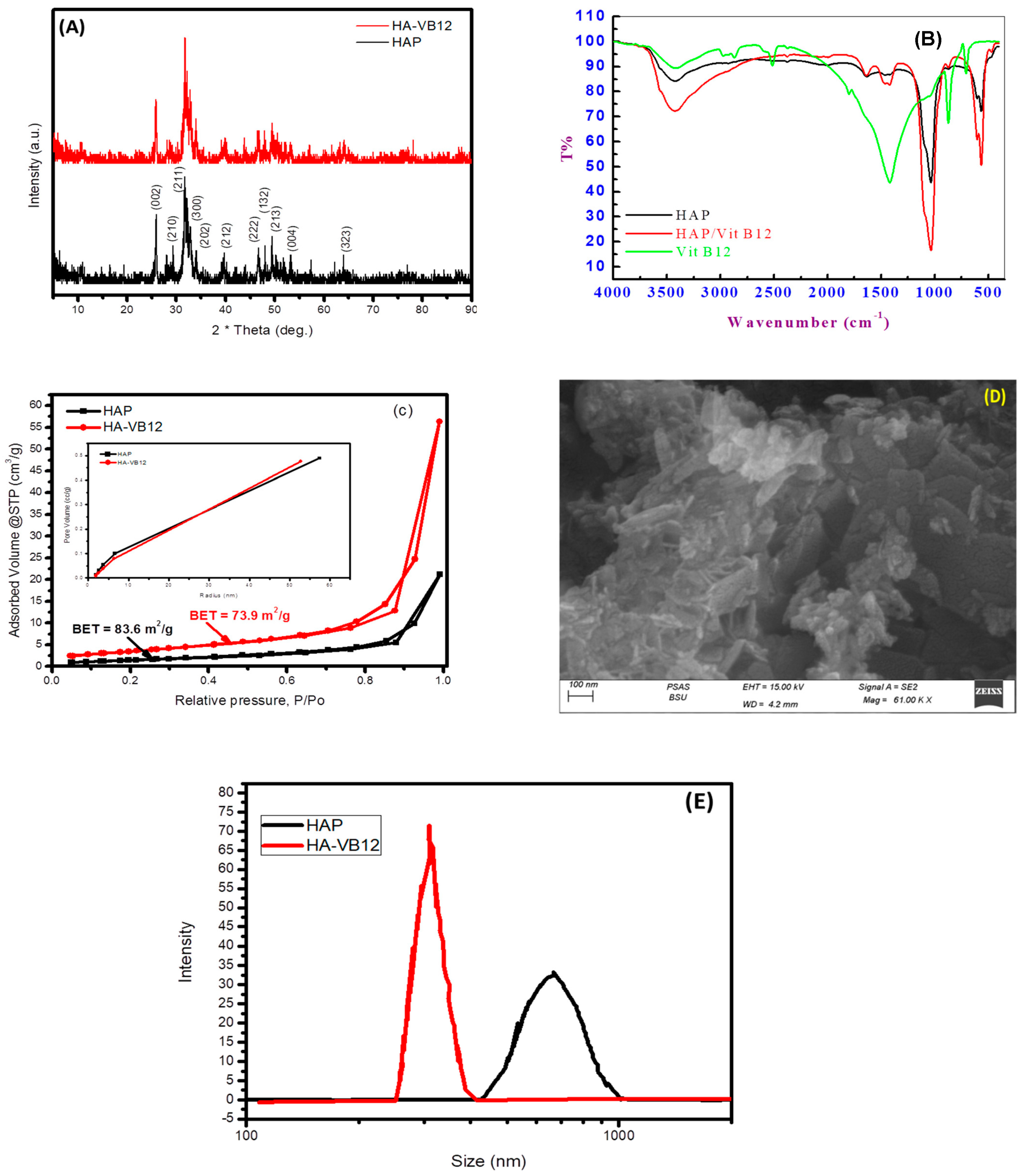
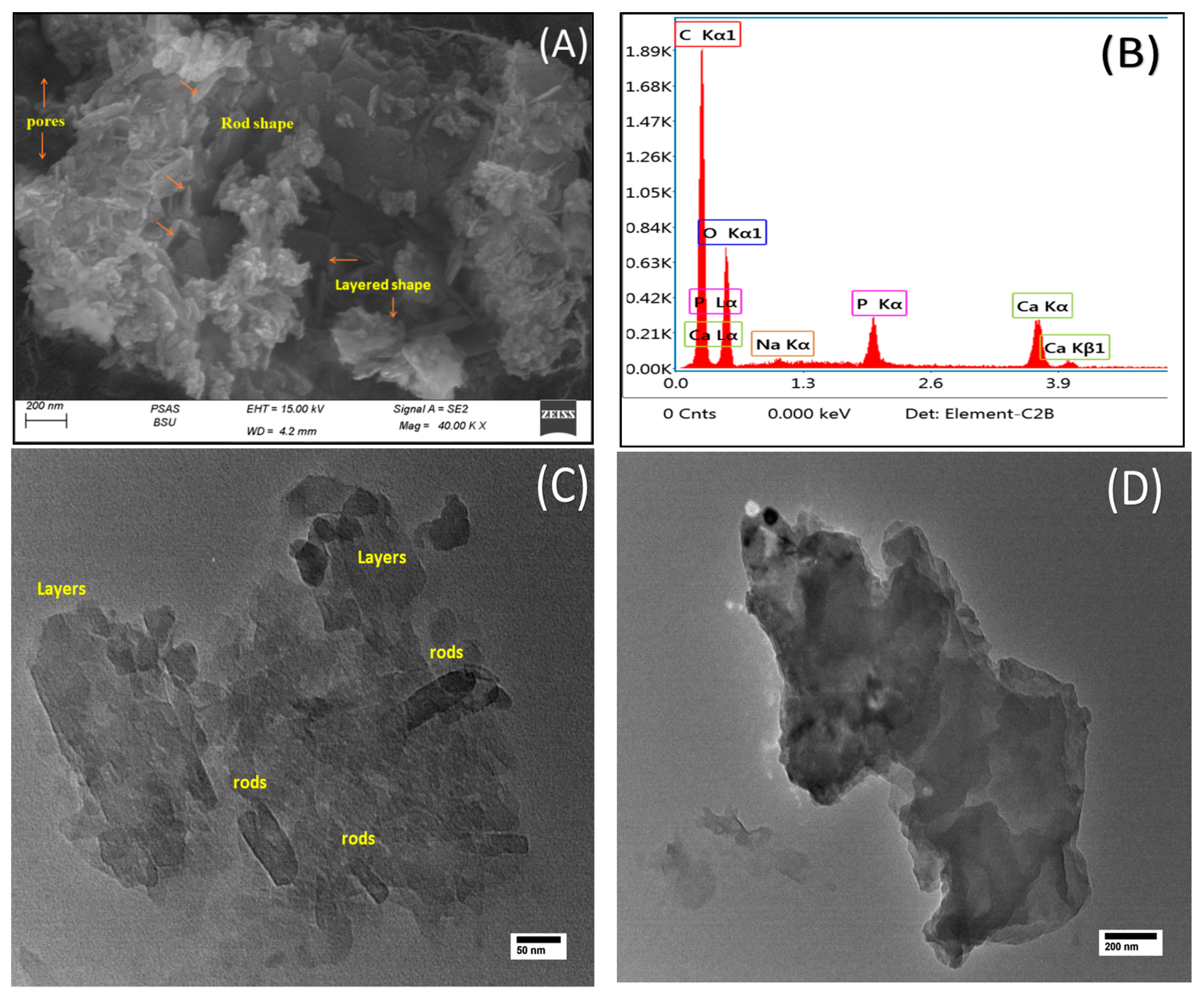
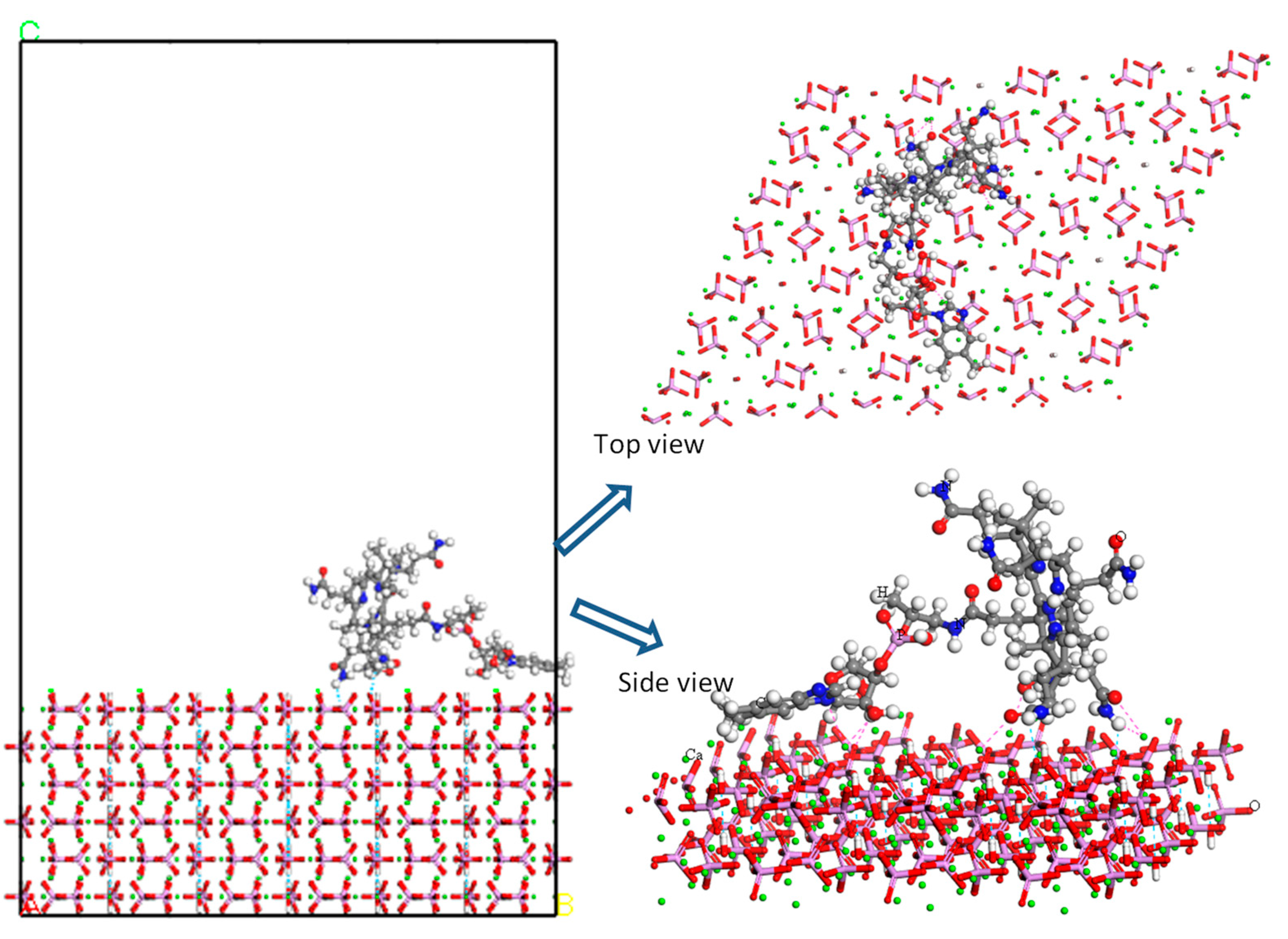

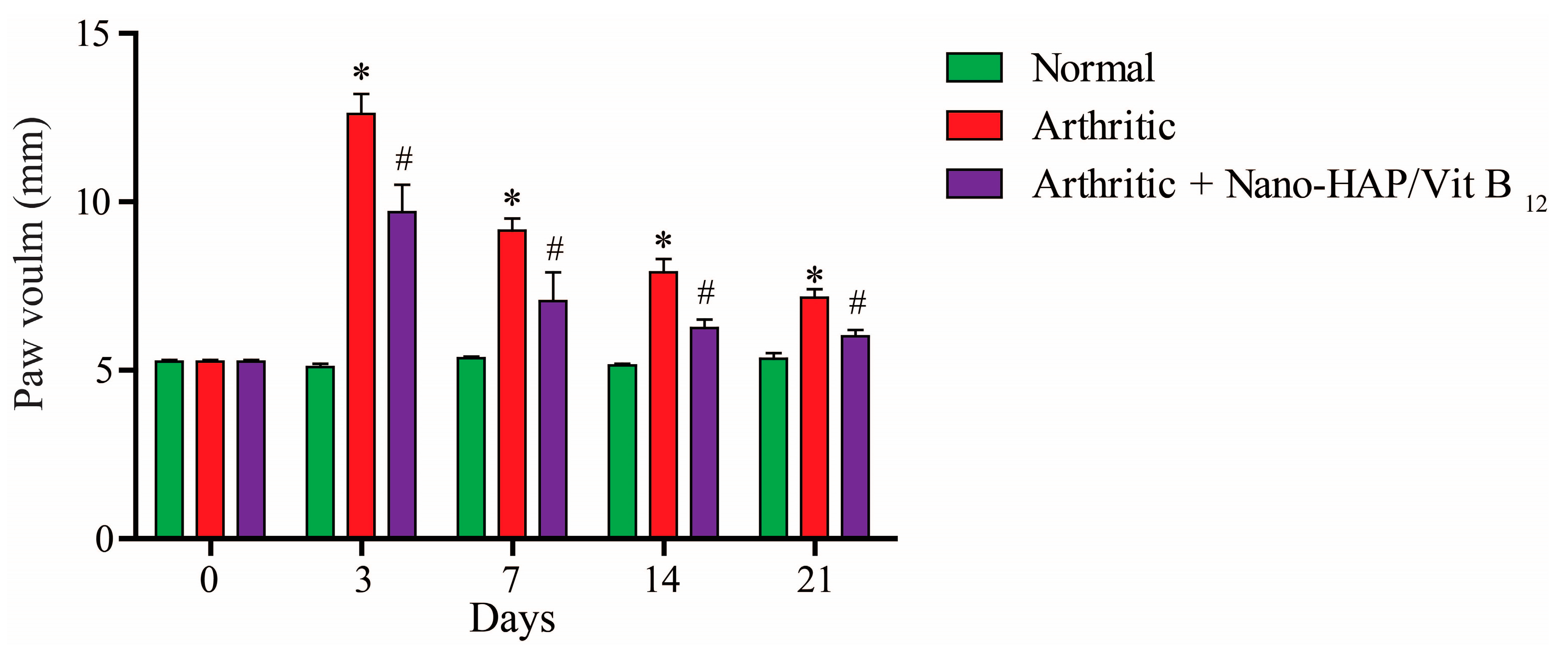
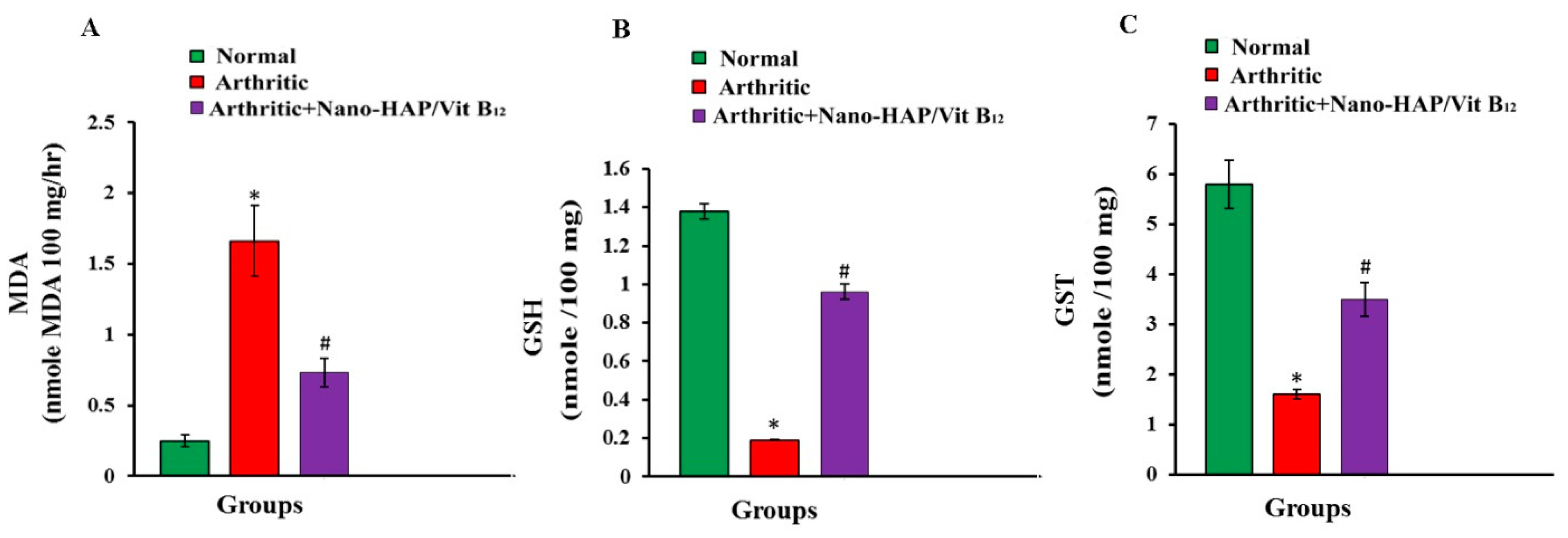

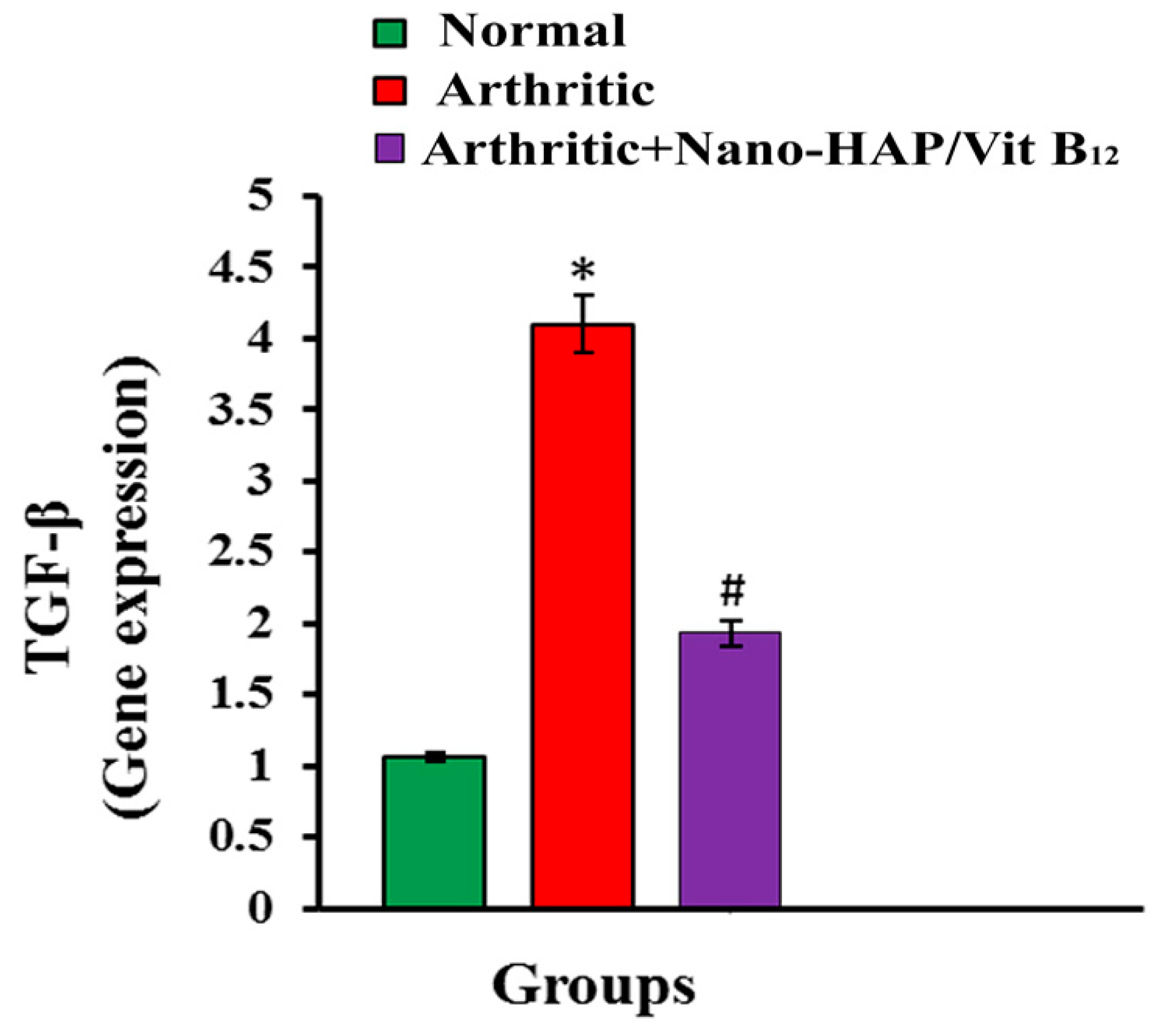

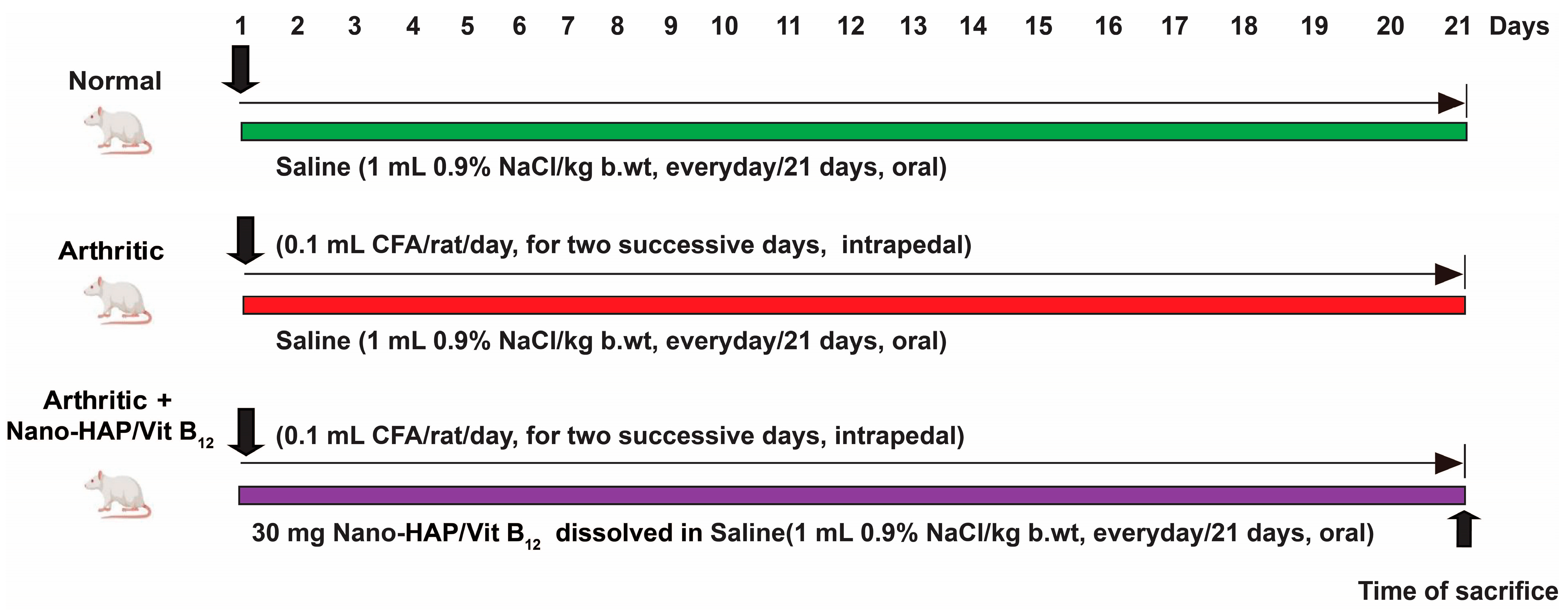

| Cavity | Synovial Lining | Inflammatory Infiltrate | Blood Vessels | Pannus | Articular Cartilage | Menisci | |
|---|---|---|---|---|---|---|---|
| Normal | 0 | 0 | 0 | 0 | 0 | 0 | 0 |
| Arthritic | 0 | ++ | +++ | 0 | ++ | +++ | ++ |
| Arthritic + nano-HAP/Vit B12 | + | 0 | + | 0 | + | 0 | 0 |
| • Cavity: | |||||||
| 0: Average | +: Narrow | ++: Very narrow | |||||
| • Synovial lining: | |||||||
| 0: Average/intact | +: Thickened/hyperplastic | +++: Necrotic/ulcerated | |||||
| • Inflammatory infiltrate: | |||||||
| 0: No | +: Scattered/mild | +++: Moderate/marked/ with excess fibroblasts | |||||
| • Blood vessels: | |||||||
| 0: Average | +: Mildly dilated/congested | ++: Markedly dilated/congested | |||||
| • Pannus: | |||||||
| 0: No | +: Small/large non-destructing | ++: Large destructing/with fibrous bands | |||||
| • Articular cartilage: | |||||||
| 0: Average | +: Mildly destructed/thickened | +++: Markedly and severe destructed | |||||
| • Menisci: | |||||||
| 0: Average | +: Mildly destructed | ++: Markedly destructed | |||||
| Genes | GenBank Accession Number | Sequence (5′–3′) |
|---|---|---|
| TGF-β | XM_032894155.1 | F: GACTCTCCACCTGCAAGACC |
| R: GGACTGGCGAGCCTTAGTTT | ||
| GAPDH | XM_017592435.1 | F: CACCCTGTTGCTGTAGCCATATTC |
| R: GACATCAAGAAGGTGGTGAAGCAG |
Disclaimer/Publisher’s Note: The statements, opinions and data contained in all publications are solely those of the individual author(s) and contributor(s) and not of MDPI and/or the editor(s). MDPI and/or the editor(s) disclaim responsibility for any injury to people or property resulting from any ideas, methods, instructions or products referred to in the content. |
© 2023 by the authors. Licensee MDPI, Basel, Switzerland. This article is an open access article distributed under the terms and conditions of the Creative Commons Attribution (CC BY) license (https://creativecommons.org/licenses/by/4.0/).
Share and Cite
Belal, A.; Mahmoud, R.; Mohamed, E.E.; Farghali, A.; Abo El-Ela, F.I.; Gamal, A.; Halfaya, F.M.; Khaled, E.; Farahat, A.A.; Hassan, A.H.E.; et al. A Novel Hydroxyapatite/Vitamin B12 Nanoformula for Treatment of Bone Damage: Preparation, Characterization, and Anti-Arthritic, Anti-Inflammatory, and Antioxidant Activities in Chemically Induced Arthritic Rats. Pharmaceuticals 2023, 16, 551. https://doi.org/10.3390/ph16040551
Belal A, Mahmoud R, Mohamed EE, Farghali A, Abo El-Ela FI, Gamal A, Halfaya FM, Khaled E, Farahat AA, Hassan AHE, et al. A Novel Hydroxyapatite/Vitamin B12 Nanoformula for Treatment of Bone Damage: Preparation, Characterization, and Anti-Arthritic, Anti-Inflammatory, and Antioxidant Activities in Chemically Induced Arthritic Rats. Pharmaceuticals. 2023; 16(4):551. https://doi.org/10.3390/ph16040551
Chicago/Turabian StyleBelal, Amany, Rehab Mahmoud, Eman E. Mohamed, Ahmed Farghali, Fatma I. Abo El-Ela, Amr Gamal, Fatma Mohamed Halfaya, Esraa Khaled, Abdelbasset A. Farahat, Ahmed H. E. Hassan, and et al. 2023. "A Novel Hydroxyapatite/Vitamin B12 Nanoformula for Treatment of Bone Damage: Preparation, Characterization, and Anti-Arthritic, Anti-Inflammatory, and Antioxidant Activities in Chemically Induced Arthritic Rats" Pharmaceuticals 16, no. 4: 551. https://doi.org/10.3390/ph16040551
APA StyleBelal, A., Mahmoud, R., Mohamed, E. E., Farghali, A., Abo El-Ela, F. I., Gamal, A., Halfaya, F. M., Khaled, E., Farahat, A. A., Hassan, A. H. E., Ghoneim, M. M., Taha, M., & Zaky, M. Y. (2023). A Novel Hydroxyapatite/Vitamin B12 Nanoformula for Treatment of Bone Damage: Preparation, Characterization, and Anti-Arthritic, Anti-Inflammatory, and Antioxidant Activities in Chemically Induced Arthritic Rats. Pharmaceuticals, 16(4), 551. https://doi.org/10.3390/ph16040551







